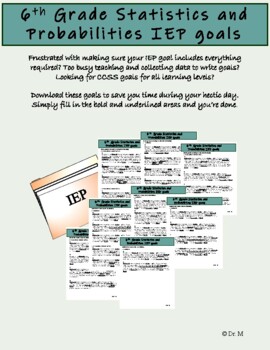6th Grade Statistics and Probabilities IEP Math goals
- PDF
Also included in
- Do you feel frustrated and overwhelmed with everything on your plate? No need to sweat the small stuff. Relieve your current and future headaches with these premade IEP goals. There is no mixing and matching needed. This premade 6th Grade Math IEP goals bundle is designed to save you valuable time,Price $25.75Original Price $30.75Save $5.00
- IEP Goal Avalanche! Bury Paperwork, Empower StudentsDo you feel like you are drowning in IEP paperwork? Do you feel lost in a sea of blank forms? This Mega Bundle of Editable IEP Goals is your life raft!This comprehensive collection provides a treasure trove of pre-written Math goals. No more startiPrice $65.75Original Price $80.75Save $15.00
Description
Do you feel frustrated and overwhelmed with everything on your plate? No need to sweat the small stuff. Relieve your current and future headaches with these premade IEP goals. There is no mixing and matching needed. This premade 6th Grade Statistics and Probabilities IEP Math goals packet is designed to save you valuable time, frustration, and headaches. Simply fill in the bold information to personalize each goal.
This 6th Grade Statistics and Probabilities IEP Math goals packet is aligned with Common Core standards and written for IDEA compliance. Each goal has several options to choose from, depending on the student's academic level and whether they are inclusive or self-contained. Every Common Core standard is listed for easy reference according to the skill.
PLEASE NOTE the purchase of one license for this product grants permission for use by one classroom/teacher only.







